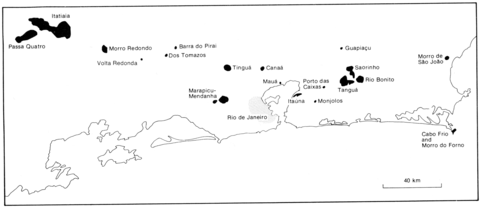stripes
Morro de Sao Joao is an approximately circular stock 3.5 km in diameter, forming a conical hill reaching 800 m. It intrudes Precambrian granitic and granodioritic gneisses which fringe the hill and then pass beneath Quaternary alluvial deposits. The principal rock types are nepheline and pseudoleucite syenites, shonkinite, malignite, intrusive breccias and a range of trachytic and phonolitic dykes, both within the intrusion and cutting the country rocks. The most abundant syenites are leucocratic foyaites comprising orthoclase and nepheline (20-45%), with variable accessories including sodalite, aegirine/aegirine-augite, amphibole of various kinds and melanite. Pseudoleucite occurs in some nepheline syenites, tinguaites and phonolites and also in a gabbro. The pseudoleucites in nepheline syenite are up to 5 cm in diameter, may have a palisade structure and are composed of 70% orthoclase, 26% nepheline and a little hastingsite, muscovite and carbonate. The pseudoleucites in phonolites and tinguaites are up to 1 cm in diameter and these rocks contain abundant sodalite (15%) and arfvedsonite (10-16%). A range of rocks of very variable colour index and containing up to 15% plagioclase, some identified as bytownite, are described as nepheline monzosyenites; these pass into alkaline gabbros, in one variety of which pseudoleucites occur, although all feldspathoid has been replaced. Amphibole fergusite is a rock exceptionally rich in large pseudoleucites and occurring as large blocks on the western side of the complex; titanaugite is also present. Blocks of calcalkaline gabbro, containing hornblende and biotite, also occur within the breccias.
AMARAL, G., BUSHEE, J., CORDANI, U.G., KAWASHITA, K. and REYNOLDS, J.H. 1967. Potassium-argon ages of alkaline rocks from southern Brazil. Geochimica et Cosmochimica Acta, 31: 117-42.
REIS, A.P. dos and VALENCA, J.G. 1979. Complexo igneo alcalino do Morro de Sao Joao, RJ. Mineracao Metalurgia, 412: 10-24.
VALENCA, J.G. and KLEIN, V.C. 1984. Complexos alcalinos situados a leste da Baia de Guanabara, Rio de Janeiro. Anais Congresso Brasileiro de Geologia, 33: 5317-33

